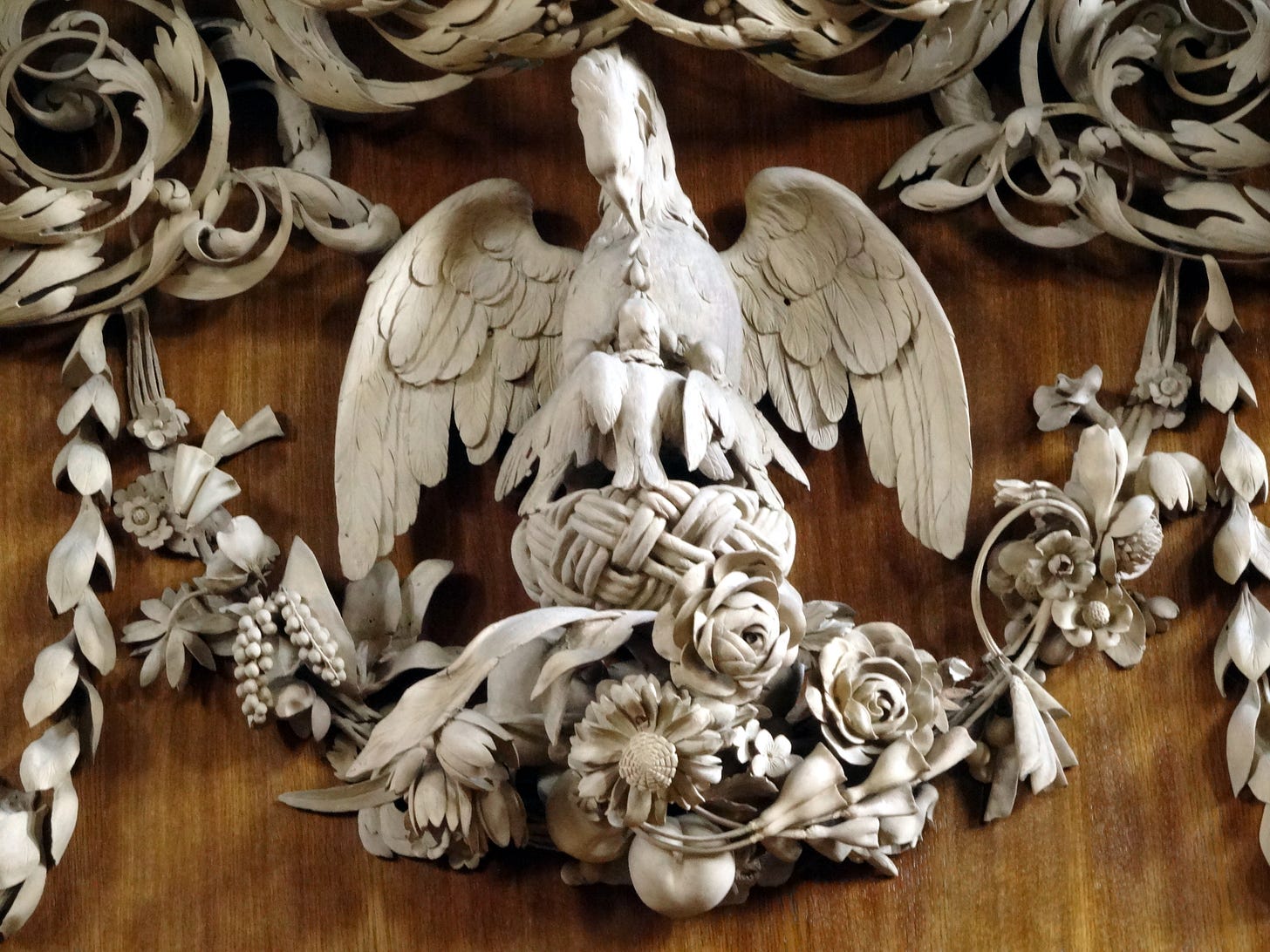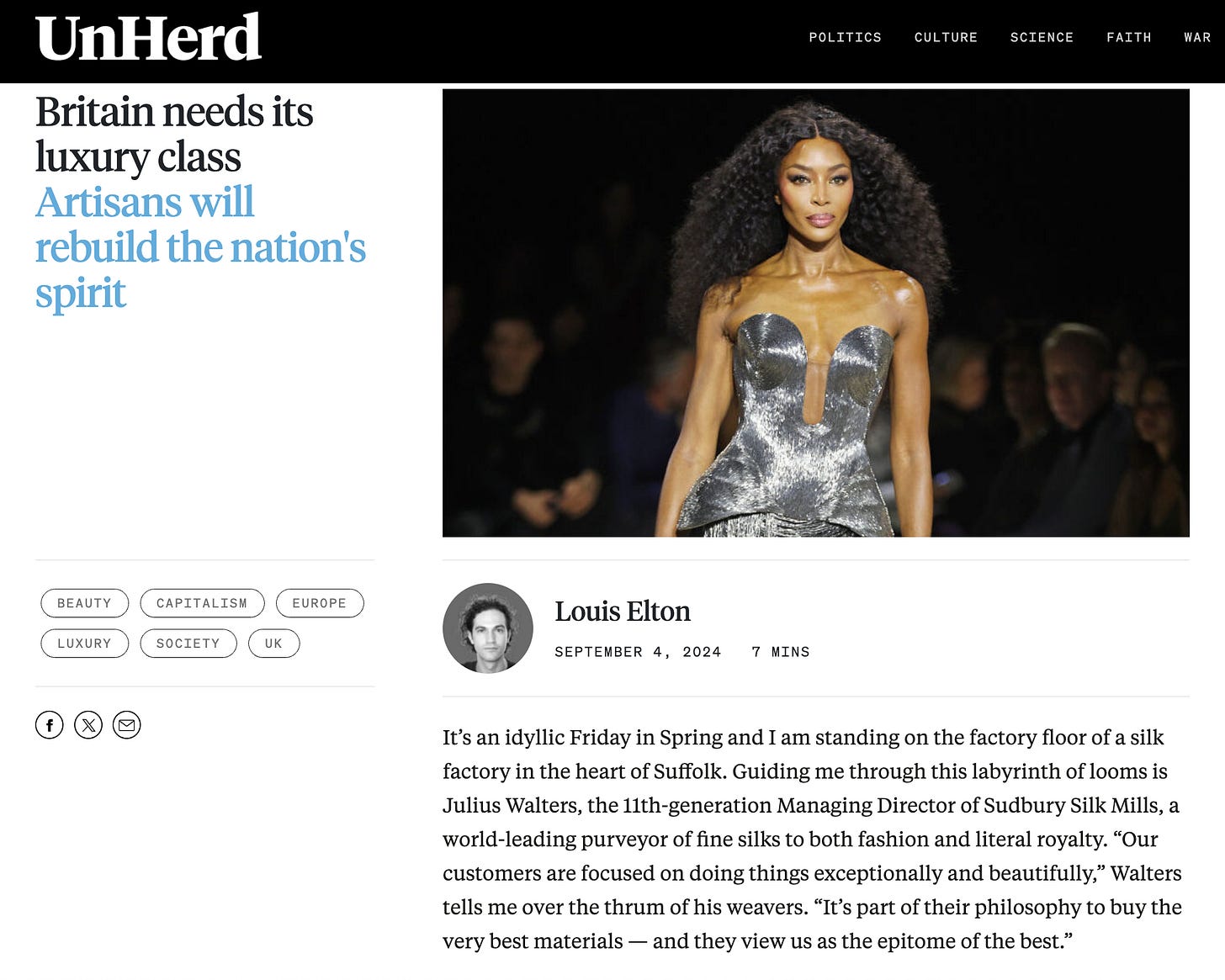My name is Louis Elton. I’m on a quest to craft an entire outfit from underwear-to-outerwear entirely in Britain. Why? To trigger a renaissance in British manufacturing and to heal the nation’s spirit, of course!
In this week’s post, a morsel of lore: a wonderful speech by Soane Britain Founder Lulu Lytle on why saving craft is saving history. The best bit is when she quotes an article I wrote before starting Nation of Artisans. Also: a big welcome to the dozens of new subscribers who came to me via
’ viral post — delighted to have you on board!1. Why the World Should Care About Preserving Craft Skills
At last year’s Design Leadership Summit, Soane Britain founder Lulu Lytle OBE delivered a barnstorming speech entitled ‘Why the World Should Care About Preserving Craft Skills’.
It’s an inspiring talk that explores the history and innovation of British craft through the lens of a series of post-fire restoration projects.
Towards the end of it, Lulu delivers a striking call for a movement of makers, restorationists, innovators to embrace total supply chain transparency in everything they do — a message that triggered this very Substack! Even more fun: there’s a bit where she quotes me👇
The Transcript
And this is the opportunity: what I'd like to do is create a kind of movement: a movement with you, architects, decorators, and makers at its heart. You who are the shapers of space, you who are at the vanguard of interior design commissions. A movement in favor of traditional craftsmanship—local craftsmen, English in England, Chinese in China, and so on—and honest, ethical business practices in our sector. A movement ideally in favor of maker visibility, but failing which, total transparency as to where makers work.
A movement that persuades clients not simply of the added value of honest craftsmanship, but also of the need to investigate provenance, to look skeptically at superficial brand mythologies—as Louis Elton (it’s me!) has so eloquently described them—and deeply at how, where, and most crucially, by whom something has been made.
And a movement that persuades you and your colleagues of the role you can and should play in informing your clients. If they care, I believe you owe it to them to ensure they understand the sources of every single thing you buy on their behalf. If they don't care, I'd like you to persuade them to care. To quote a well-known arbiter of taste, Miss Piggy, "Beauty is in the eye of the beholder, and it may be necessary from time to time to give a misinformed beholder a black eye."
I believe that such a movement could make a real difference and that it would be a better, a happier, culturally and aesthetically richer, and most importantly, a more honest world if we did. We need to ensure that traditional craftsmanship—true craftsmanship—local, ethical craftsmanship, survives into the next generation and the one after that.
How many producers that you buy from show you the full picture? How many pay lip service to the principles I have espoused today but don't actually respect them in practice? Let me put it another way: if something is made almost entirely in China and only assembled or finished in America or Europe, do you or do you not think that you and your clients should be aware? Do you think they are aware? You see, I know that many are not, and we all know that this is wrong—an unethical deception.
I know, too, that I often find myself listening to professionals—both in interiors and fashion and food—waxing lyrical about products that even a cursory glance should suggest are not everything they claim to be. Some are undeniably very good, but too many are mediocre and potentially harmful, and a fair number truly shoddy and destined for tomorrow's landfill.
I know that many companies find it all too easy to promote their European or American creatives and assemblers while effectively making invisible the craftsmen who have essentially made the item—makers who are typically Asian, upon whom these businesses and massive margins are built, are removed entirely from the story. In doing so, these businesses are erasing the narrative of the true maker and imposing a new, false narrative, whilst at the same time shouting from the rooftops about their supposed support for diversity.
And I know that too many journalists are seemingly unaware of or perhaps happy to play along with this deception. But it does need our support, and I'm hoping that today can be the beginning of a real shift in our community.
On which note, here, to end—because I mentioned him earlier—is a Grinling Gibbons carving from the altar of St. James's Piccadilly. One of my favorites: the pelican in her piety. Isn't it extraordinary? I've chosen it as my parting image because it's a depiction of the survival of the next generation. That pelican is taking desperate measures to feed her chicks, to ensure their survival. I've chosen it as a reminder of just how good traditional craftsmanship can be and how incredibly important it is that we nurture it. Thank you very much.
For the curious: the pelican in question
I recommend you watch the full video here:
If Lulu’s message resonates, then you should subscribe for free because that’s what Nation of Artisans is all about…
2. The Original Piece
If you want to dive deeper, you can read the piece Lulu quotes here
3. What else is going on in Nation of Artisans?
I’ve been away for a couple of weeks, so things have been a little slower. However, progress has been whirring in the background; the wheels of industry and craft are turning. Some updates:
The Instagram has now crossed 2000 followers — at such an early stage of the project, this is reassuring: I am seemingly not shouting into the wind. Follow here!
The Nation of Artisans Design Prize judges have been assembled, and we will meet to decide winners in the next couple of weeks. Announcement to come on June 1st.
A second film is in the process of being commissioned — more to be revealed.
Now, please hit that ❤️ button at the bottom and share with all of your friends so the Substack algorithm is kind to me.
Until next time.







As a pelican enjoyer, this is a nice piece indeed.
Beautiful talk!